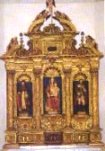The first
human settlements on this
zone date back to the pre-roman
period, when fortified areas
( "castellieri"
) were built up by the Celts,
the Gauls and the Carnics,
who were the former inhabitants
of this region. After some
crossings with the Venets
it was the turn of the Romans,
who introduced the so called
" centuriazione ",
or the geometric splitting
of the cultivable territory
in many allotments of the
same extension, which were
granted to the soldiers (
centurions ) in accordance
with planned rules. Heritage
from the times is also the
praedial toponymy, through
which the places took the
name of the landlord. Today
we can see many examples of
toponymies and Aviano as well
consists of the suffix "anum"
(in latin meaning "belonging
to") added to the roman
family name "Avilius".
|
When
in the V century A.C. the
Romans were pushed out by
the Goths and the Longobards,
the Christian faith started
to lay its foundations in
the countryside through the
first parish churches, called
"pievi", acting
as evangelization centres
as well as strongholds of
culture and linguistic innovation.
The castle of Aviano was erected
after the savage raids of
the Hungarians (X century
A.C.). It represented the
leading place of the area,
around which the rural communities
started building their own
fortifications known as "cortine"
or "cente" in order
to defend themselves. |

|
These
fortified farms were perfect
little castles with thick
walls and bars on the windows,
useful for giving shelter
to people and animals and
for storing food and hiding
treasures during the raids
carried out by nomadic tribes.
Today, examples of this typical
architecture can be seen almost
everywhere in the Pedemontana
area. |
 |
At
the beginning of the XV century
Aviano fell under the rule
of Venice, lasting about four
centuries till the end of
the " Serenissima "
republic in 1797. During this
period Aviano and all the
Friuli sufferedtwo raids by
the Turks in 1477 and 1499,
which left heavy damages and
loss of people. Probably also
for this reason two centuries
later an illustrius citizen
of Aviano, raised to the altars
with the name of Saint Marco
D'Aviano, took an important
part to the struggle leading
to the final defeat of the
Turks at Kahlenberg in 1683.
Afterwards, Aviano was ruled
by the French before being
absorbed in the Austro-Hungarian
Empire till 1866, when the
region of Friuli was annexed
to the Kingdom of Italy. |
Today,
after the end of monarchy
in 1946, Aviano is a town
of the self governing region
Friuli Venezia Giulia. The
territory around Aviano is
characterized by valuable
examples of expressive countryfolk
architecture, so called "spontaneus".
Interesting artistic works
are preserved in many holy
places, such as the Pieve
of Aviano, the Church of San
Giorgio and the Church of
Santa Giuliana, both in Castel
d'Aviano (a burgh of the town).
|
Aviano(home)
San
Gregorio |
Worth
seeing for its splendid location,
the Sanctuary of the Madonna
del Monte ( Lady of the Mountain
) stands out of the hills.
The church, harmonious in
its classical style, was built
to commemorate the apparition
of the Blessed Virgin Mary
to a peasant, such Antonio
Zamparo, on 8th September
1510 |
 |
|
|
|
|
|
| |
|
| |
| |
CiaoVenezia
Via della Centa, 30
33070 Polcenigo (PN) Italy
Fax +39 0434 749634
e-mail:
info@ciaovenezia.com
|
|
|